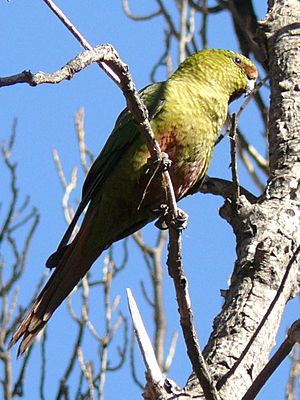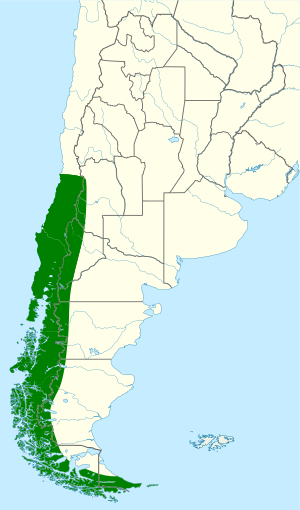Austral parakeet facts for kids
Quick facts for kids Austral parakeet |
|
|---|---|
 |
|
| Conservation status | |
| Scientific classification | |
| Genus: |
Enicognathus
|
| Species: |
ferrugineus
|
 |
|
| Synonyms | |
|
Microsittace ferruginea |
|
The austral parakeet, also known as the austral conure or emerald parakeet (Enicognathus ferrugineus), is a type of parrot. It belongs to the Psittacidae family, which includes African and New World parrots. You can find this bird in Argentina, Chile, and possibly the Falkland Islands.
Contents
About the Austral Parakeet's Family Tree
The austral parakeet is closely related to the slender-billed parakeet. Both birds are part of the same group, called a genus, named Enicognathus. Long ago, the austral parakeet was the only bird in its own genus, Microsittace.
This parakeet has two main types, called subspecies:
- The first type is E. f. ferrugineus, named by Philipp Ludwig Statius Müller in 1776.
- The second type is E. f. minor, named by Chapman in 1919.
What Does the Austral Parakeet Look Like?
The austral parakeet is about 28 to 36 centimeters (11 to 14 inches) long. One male E. f. minor weighed about 155 grams (5.5 ounces). Both male and female parakeets look the same.
Adults of the main subspecies have a dull reddish color on their forehead and around their eyes. The rest of their face is yellow-green. Their upper body is dull green. Their belly is yellowish-green with a dull reddish patch. The edges of their feathers are dark, which makes them look a bit scaly. Their tail is also dull reddish, and their wings are mostly green with bluish-green flight feathers.
Younger birds look similar to adults. However, the red colors on their face and belly are even duller. The E. f. minor subspecies is smaller and has darker colors than the main subspecies.
Where Do Austral Parakeets Live?
The austral parakeet lives further south than any other parrot in the world. The E. f. minor subspecies lives in southern Chile, from the O'Higgins Region down to Aysén. It also lives in nearby parts of southwestern Argentina, from Neuquén Province to northwestern Santa Cruz.
The main subspecies lives from where E. f. minor stops, all the way down almost to Cape Horn. There have been some unconfirmed sightings in the Falkland Islands. Because of this, experts are still checking if the bird truly lives there.
These parakeets mostly live in forests with southern beech trees (Nothofagus). They also like woodlands with oaks (Quercus) and Drimys andina trees. You can also find them in open areas nearby, on ranches, and sometimes even in farm fields. In the far south, they usually live near sea level. But further north, they can be found as high as 2,000 meters (6,600 feet) up in the mountains.
Austral Parakeet Behavior
How Austral Parakeets Move Around
Austral parakeets stay in the southern parts of their home range all year long. In the northern areas, they move to different elevations. These movements are not always tied to seasons. Instead, they seem to move based on the weather and how much food is available.
What Austral Parakeets Eat
Austral parakeets often look for food in large groups. These groups can have up to 100 birds. Sometimes, other bird species even join them. Their diet includes seeds from grasses, bamboo, and the "Chilean pine" (Araucaria araucana). They also eat fruits, berries, acorns, and young leaf buds. In the northernmost part of Argentina, they have been seen eating insect larvae.
How Austral Parakeets Raise Their Young
The breeding season for the austral parakeet includes December, but it is not fully known when it starts and ends. They usually build their nests inside holes in trees. Large dead oak trees seem to be their favorite nesting spots. They have also been seen making nests out of twigs in bamboo plants. A female parakeet usually lays four to eight eggs. When kept in captivity, the eggs hatch after about 26 days.
What Austral Parakeets Sound Like
The most common sound the austral parakeet makes is a "nasal grating note." It often repeats this sound many times, like "grrreh-grrreh-grrreh..." They also sometimes mix in a "more drawn-out, higher-pitched 'kreeh'."
Austral Parakeet Conservation Status
The IUCN (International Union for Conservation of Nature) has listed the austral parakeet as a species of "Least Concern." This means they are not currently worried about it becoming endangered. The bird lives across a very large area. Even though we don't know the exact number of birds, their population is thought to be stable. No immediate threats to their survival have been found. They are considered common throughout the places they live, and much of their habitat is protected in national parks.
See also
 In Spanish: Cachaña para niños
In Spanish: Cachaña para niños


